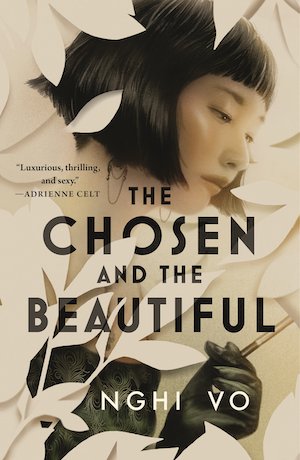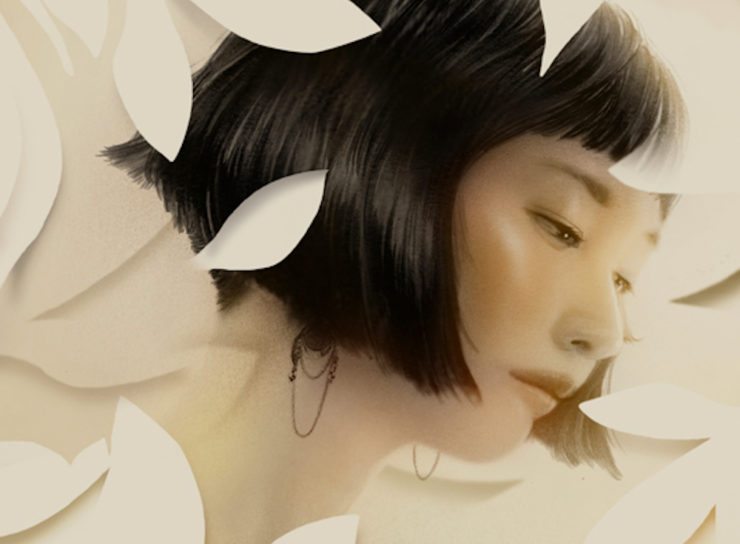In the world of The Chosen and the Beautiful, magic is a force not unlike electricity. In the 1920s, electricity ran the cities, holding back the night. At the same time, it was a toy for those who could afford it. Vast swathes of the country lived as they had always lived in darkness and in the cold, and so magic in Jordan Baker’s world is power and privilege.
To me, Jordan Baker came into the story of The Chosen and the Beautiful as a naturally talented magician, one with an instinctive knack for the magic that is inherent to her lost homeland. It was such a part of her that I never questioned it, and it serves as both a link to her past and a path to her future, one where she can learn not only about who she is, but who she can become.
In my novel, papercutting magic, which transforms cut-paper forms into living figures with their own kind of life, is a form of magic unknown in the west, a source of wonder and curiosity. While Khai and the paper-cutting troupe turn this magic into an entertainment to pay the bills, there are darker hints of stronger spells, paper soldiers and a world where paper not only bleeds, but may marry and have rights. As a woman of privilege, Jordan gets to ignore this power that she was born with, choosing to rely on her wealth, her beauty, and her wits to get by, and her own relationship with her innate talent is a rocky and untrustworthy thing.
While the papercutting of the book is a fantasy based on various pieces of papercutting work I saw and admired, papercutting is a real-world art that has its own long history. A closer look at paper-cutting reveals an ancient art that persists to this day, in new and exciting forms that are still evolving to suit the artists who admire it. While modern examples of papercutting are found in the world’s most prestigious museums, going back to examine its humble roots gives insight into both the people who saw beauty in scraps and the cultures that produced them.
The history of papercutting actually predates the invention of paper. Paper was invented in China sometime during the Eastern Han Dynasty, around 100 CE, by a palace official in the court of Emperor He known as Cai Lun. While papercutting was first officially documented by the sixth century, the shapes and themes that characterize the art hearken back to decorative cuttings made using thin leather, fabric, silver foil, and even leaves.
In The Chosen and the Beautiful, papercutting magic appears as a marker of Jordan Baker’s lost homeland, something at once beautiful and frightening that ties her to a heritage she has never known. For Jordan, in a world drowning in wonder, the art of papercutting is a link to her past. In our own world, the history of papercutting likewise leads us to a rich tradition of folk art and storytelling.
Buy the Book


The Chosen and the Beautiful
Today, papercutting is recognized as a fine art, but the cheapness and wide availability of paper has made it one that could be refined and enjoyed by people at all levels of society, and many different styles of papercutting can be found throughout the world. In China, papercutting is known as jianzhi. Historically it has been divided into the northern style and the southern style: where papercutting in the north prioritizes smooth evocative lines, papercutting in the south is more elaborate, concentrating on very detailed creations using very delicate lines.
Most of the earliest Chinese papercutting artists were illiterate. Instead of adorning their walls with calligraphy or fine paintings, they decorated their living spaces with attractive paper cuts produced from the materials they had at hand. Many of the designs were comparatively simple, but others were pieces of great beauty featuring flowers, animals, and intricate geometric shapes.
Although there were some artists who sold their work professionally, papercutting was also considered a craft suitable for anyone who could hold a sharp knife or a pair of scissors. It uses the same skills and many of the same tools as fabric cutwork and counted-thread embroidery, and women looking to decorate their homes gravitated towards the graceful forms shaped from colorful paper. These works could be displayed year round, but they were very popular around the Lunar New Year, when paper cuts would be pasted in fresh paper windows to welcome a new beginning.
While China claims the invention of modern paper, papercutting as an art is a global phenomenon. The secret of paper-making emerged in Europe during the 13th century, and today there are many papercutting traditions of note. In Germany, there is scherenschnitte, where paper may be folded and then cut to produce art with repeating geometric motifs. The folded snowflake that so many children learn to cut is an example of German scherenschnitte. Papercutting is also considered a Jewish folk art dating back to the Middle Ages, where papercutting designs were used to adorn marriage contracts and as holiday decorations. In Japan, papercutting developed very quickly after the introduction of paper. Japanese papercutting, known as kirie or kirigami, covers many different styles and produced related art forms, like kamikiri, a performance where an artist cuts paper while taking suggestions from the audience.
Far from being a thing of the past, papercutting is an art that has moved with the times. No longer restricted to knives and scissors alone, modern papercutting artists make use of everything from stamps, stencils and die-cutters to holographic paper, multiple layers of exceedingly thin, fine paper, and globally sourced designs. Where once papercuts were simply pasted to windows, today they may be framed, mounted and folded as pieces of 3D art or added to products ranging from furniture to electronic devices.
To learn more about the art of papercutting and its place in our shared world, consider a visit to the China Paper Cutting Museum in Yangzhou, China, the Guild of American Papercutters National Museum in Somerset, United States, or the Musuem of Paper in Amalfi, Italy!
***
How To Cut Paper
Khai, Bai, and the rest of the papercutting troupe make papercutting look easy, and while it takes years to learn to make the intricate paper cuts that they have mastered, there’s nothing stopping you from making simpler designs for your own home!
GATHER YOUR TOOLS
While you can cut paper designs with nothing more than a stable surface and a craft knife, there are some other tools that can help you get a clearer, cleaner end result. A cutting mat and masking or artist’s tape will make things much easier for you.
CHOOSING YOUR PAPER
You can make paper cuts with nearly any paper. Your local craft store will have plenty of decorative papers to choose from or you can look around your house for spare paper that might work for this purpose. Remember that it is easier to cut thin paper than thick paper, but thin paper is easier to tear. Printer paper is actually a bad choice for this art as it blunts your craft knife very quickly.
PICKING A DESIGN
You can freehand a sketch on the back of your decorative paper or you can use a stencil to create your desired design. There are also kits that come with designs printed onto the decorated paper, and you can simply cut them out directly. Remember that when applying a design to the back of the paper that it should be reversed so that it is correct when the paper cut is turned over to the right side.
SECURE YOUR WORK
Tape your work to a cutting mat using masking or artist’s tape. If you are working with a stencil, put your decorative paper down first, and then place the stencil on top of it, securing them with tape. This prevents the paper from slipping and allows you to make cuts with confidence. Some people like to cut from the back of a piece of paper while others like to cut from the front- in general, the side of the paper facing down as you cut will have a neater look.
CUT, CUT, CUT
Using your craft knife, start by cutting out the smallest pieces of the design first. As the larger pieces are removed, the paper becomes less stable, and the smaller pieces will be harder to do. Work from the center of the design out to the edges. As you get to the larger pieces of the design, turn your work so that you are still making controlled cuts. Remove the pieces as you go so you can see your progress. If you accidentally cut through an element of the design, you can always repair it with a tiny sliver of tape applied afterwards from the back.
FINISHING UP
When your design is cut out completely, remove it from the mat. At this point, you can frame it with another decorative piece of paper behind it, tape it to a window or glue it to something that needs to be a little prettier!
Learn more about Jordan Baker’s world in The Chosen and The Beautiful’s Book Club Kit!
Further reading:
- Resources for Papercutting
- All About Papercutting
- Origami.me: Eastern-style origami dragons
- Béatrice Coron: links
Nghi Vo is the author of the acclaimed novellas When the Tiger Came Down the Mountain and The Empress of Salt and Fortune, a Hugo Award and Ignyte Award finalist and the winner of the Crawford Award. Born in Illinois, she now lives on the shores of Lake Michigan. She believes in the ritual of lipstick, the power of stories, and the right to change your mind. The Chosen and the Beautiful is her debut novel.










